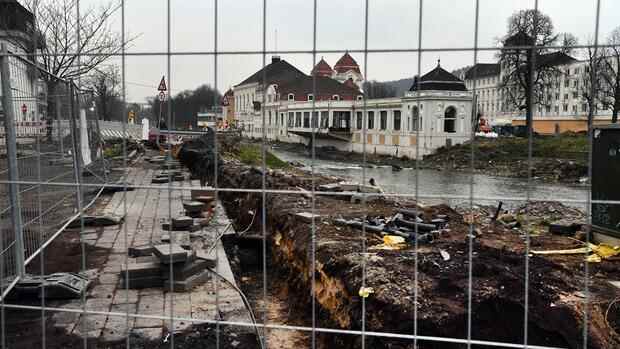Even six months after the flood disaster on the Ahr, much of the damage has not yet been repaired.
(Photo: imago images/Bonnfilm)
Munich German insurers are looking to 2022 with cautious optimism. Overall, the industry expects premium growth of two to three percent. “We expect increasing income across all sectors,” said Wolfgang Weiler, President of the General Association of the German Insurance Industry (GDV) on Thursday.
The reason for this is, among other things, that many customers are looking for more protection after the devastating flood disaster caused by storm depression Bernd last summer. Providers have been feeling the increased demand for so-called extended coverage, which also includes protection against high water and flooding, for example, since the summer. In the past year, premium income increased by 1.1 percent.
This contrasts with the loss balance for the past year, in which the industry had to make record claims payments of 12.5 billion euros. For the first time since 2013, German property and casualty insurers lost money as a result.
According to preliminary calculations, the so-called combined ratio, which shows losses as soon as the number exceeds 100 percent, is 129 percent, the highest value since the evaluations began. The previous high of 120.9 percent from 2002, when the levels of the Elbe and Danube rose massively over the banks, was thus far exceeded.
Top jobs of the day
Find the best jobs now and
be notified by email.
Unsurprisingly, homeowners’ insurance stands out among non-life insurance. The combined ratio there is 143 percent. In the previous year, insurers were still making good money in this area with a rate of 94.4 percent.
Natural hazards: an alternative to compulsory insurance
From the point of view of the customers, who have so far reported a good 250,000 individual claims to the insurers, a lot has remained unpaid. Less than half of the damaged property owners are also insured against natural hazards such as high water and flooding in addition to home building insurance.
Instead of mandatory compulsory insurance, as demanded by some politicians after the catastrophe, insurers have been proposing a variant for some time in which customers can consciously decide against insurance against natural hazards after an information meeting. Specifically, the industry association is demanding a transitional law from the federal government, with which all existing contracts are to be converted by a deadline.
“Every homeowner would have to pay a risk-based premium for this in the future,” said GDV President Weiler on Thursday. Stiftung Warentest recently put the additional costs for homeowners, who are not yet insured against natural hazards, at around 100 euros per year for nine out of ten German households.
Pandemic impacts life insurance
Nothing would change for those who are already fully insured. However, the freedom of decision of the individual is preserved through the possibility of actively objecting to the insurance cover. Norbert Rollinger, head of the cooperative R+V insurance, has already noticed a rethinking in the population. “In the long term, I expect penetration of 80 to 90 percent in the population.”
While the focus in property insurance is on severe natural catastrophes, life insurance is likely to be shaped by the effects of the corona pandemic again this year. For the current year, the industry expects premium growth of one to two percent. There was a slight decline in the past year.
Within the product world, the development of the past few years should continue in the future: Capital market-oriented products that offer more freedom in investing and thus more opportunities and risks should remain in demand. Also because the insurers are continuing to expand this offer and are steering customers in this direction in sales.
Surprising increases in Riester and Rürup pensions
By contrast, classic life insurance policies with guaranteed interest rates are likely to continue to lose importance. On the one hand because the guaranteed interest rate has fallen from 0.9 to 0.25 percent since this year, and on the other hand because a number of insurers no longer offer these products at all.
The Riester pension, which has been considered a phased-out model for years, recently proved to be a big surprise. The Germans took out 310,000 policies last year, more than at any time since 2016. “Subsidized old-age provision remains in demand among customers, although many changes are currently being discussed here,” says Gerhard Müller, deputy head of the Presidential Committee for Old-Age Provision at GDV.
The so-called basic pension, also known as the Rürup pension, was even more in demand than the Riester pension. Around 119,000 contracts, almost 40 percent more than in the previous year, were concluded in 2021. This form of retirement provision is particularly popular with the self-employed.
More: “Catch up arrears quickly” – financial regulator warns insurers about sustainability
